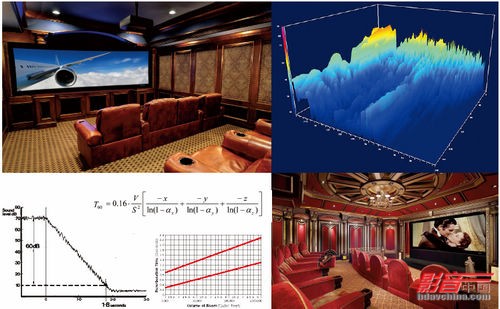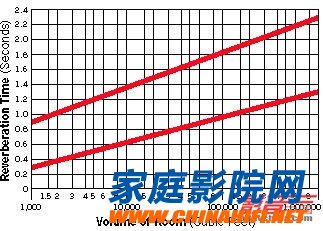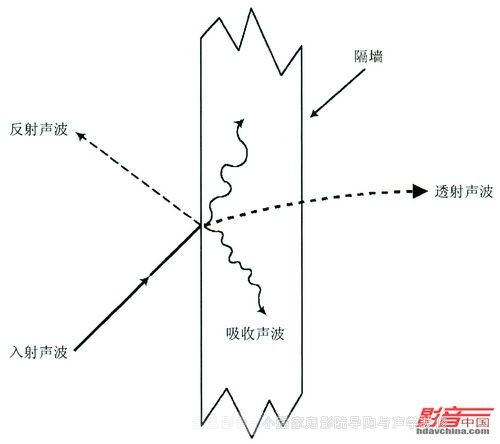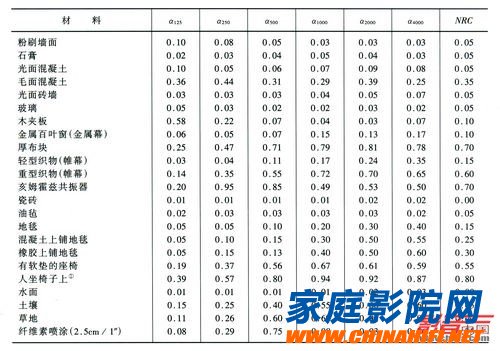In the design of audiovisual space, room size and proportion are prerequisites that must be considered before building an audiovisual space to avoid the problem of acoustic dyeing caused by the congenital deficiency of the room. For the built-in audio-visual room, in order to obtain excellent sound characteristics, it is necessary to perform post-sound processing. Among them, reverberation time control is the primary link. Reverberation time, an acoustic term proposed by Sabin, the father of modern architectural acoustics, more than 100 years ago, brought acoustic control from the state of only fuzzy prediction to the stage of digital quantification for acoustic experts and designers. Audio-visual enthusiasts can use mathematical calculations to perform more accurate room acoustic processing. Subsequently, acoustic experts created the recommended range of optimal reverberation time, standardizing and standardizing the reverberation time control of the audio-visual room.
 All in all, to get the desired sound performance, the room's reverberation time should be appropriate, not only related to whether the sound is pleasing to the ear, but also closely related to the authenticity of the sound. Too short reverberation time will make the sound dry, not loud and full; too long reverberation time will make the sound ambiguous, not real and natural. After a century of research and development, through the precise control of the reverberation time, many excellent concert halls, concert halls, recording studios and home audio-visual rooms have been born, allowing people to enter the era of high-quality audio-visual appreciation.
All in all, to get the desired sound performance, the room's reverberation time should be appropriate, not only related to whether the sound is pleasing to the ear, but also closely related to the authenticity of the sound. Too short reverberation time will make the sound dry, not loud and full; too long reverberation time will make the sound ambiguous, not real and natural. After a century of research and development, through the precise control of the reverberation time, many excellent concert halls, concert halls, recording studios and home audio-visual rooms have been born, allowing people to enter the era of high-quality audio-visual appreciation. In this issue, we will explore the concept of reverberation time, the recommended standard for optimal reverberation time, and how to more effectively carry out the control of reverberation time, so that readers can learn more comprehensive audio-visual room mix. Time control, not the tip of the iceberg.
The birth of the concept of reverberation time
In the design of audiovisual space, the reverberation time is the same important parameter as the resonant frequency discussed in the previous period, which plays a key role in the sound quality of the room. Proper reverberation time can make the sound performance more full and natural, and the details are more abundant. Too short reverberation time will make the sound dull and monotonous, while too long reverberation time will make people feel that the sound is long and the bass is roaring. The emergence of the concept of reverberation time is an important symbol of the birth of modern architectural acoustic systems. Before the establishment of the modern architectural acoustic system, architectural acoustics has attracted the attention of people of insight in ancient times.
In the 1st century BC, the Roman architect Vitruvius recorded the method of adjusting the sound with the resonance cylinder of the ancient Greek amphitheatre in the "Building Ten Books", identifying the non-sound zone, the reverberation zone, the reverberation zone, and the ringing Four different acoustic areas in the area. In the 16th to 17th centuries, the influence of reverberation time on indoor sound quality has received much attention. When building large theaters and churches in European countries, the space is tens of thousands of cubic meters, but the audience and worshippers are a few, plus the interior uses smooth interior walls such as marble, so that the reverberation time of the entire space reaches several seconds. The length of the speech in front of the voice has been blurred to the rear, such a bad sound situation has become an urgent problem to be solved. At the beginning of the 19th century, the German book "Acoustics" by EF Freidrich Chlaudi explained the phenomenon of reverberation. In the mid-19th century, the British physicist Lord John William Rayleigh published the masterpiece "Acoustics Principles". Acoustics developed into an independent branch of physics, which opened the curtain of modern acoustics. Welcome to China Home Theater Network!
From the late 19th century to the early 20th century, Wallace Clement Sabine, a professor of physics at Harvard University, pioneered the modern architectural acoustic system and brought the concept of reverberation time. The lecture hall in the newly built Harvard University Museum of Art in 1895, because of the poor acoustic characteristics, made it impossible for the students under the stage to hear the teacher's speech. So, Sabine, who was still a teaching assistant, was ordered and tried to find an answer that can be explained mathematically from the scientific point of view. Sebin and the two laboratory assistants selected three theaters with different acoustic characteristics as real physical models, including the Sanders Theatre with excellent sound performance, the Jefferson Hall lecture room with sound performance and the poor sound performance. Fogg lecture hall. At the same time, the basement of the Jefferson Hall was equipped as a reverberation test room, using hundreds of soft cushions from Sanders Theatre for experiments. With the organ as a sound source, a mid-range sound of about 512 Hz is generated in the room, and then the sound source is cut off, and then the sound is cut from the cut to the decay to the time it is not heard. The instrument is only the stopwatch and the tester's ear. After exhaustive research and testing, it is concluded that when the sound source stops sounding, the indoor sound field gradually weakens to the time that cannot be heard, that is, the reverberation time, which is an important parameter to measure the indoor sound quality.

The ordinate of this figure is the room sound pressure value, the abscissa is time, and the reverberation time is the time that the sound pressure level is attenuated by 60 dB after the sound source stops sounding. The reverberation time on the way is 1.8s

The larger the room size, the longer the reverberation time. The recommended values ​​for the best reverberation time in international organizations and organizations are usually a range, including minimum and maximum values.
The reverberation time was later defined as the time it took for the sound pressure level to decay by 60 dB after the indoor sound source stopped sounding, in seconds. The reverberation time is proportional to the volume of the room and inversely proportional to the average sound absorption coefficient of the room. Therefore, the larger the room volume, the longer the reverberation time; the larger the average sound absorption coefficient, the shorter the reverberation time. This is the famous Sabin reverberation formula: RT60=0.161V/(S×a), where T is the reverberation time, V is the room volume, S is the total surface area of ​​the room wall, and a is the average sound absorption of the room surface. coefficient.
[page]
The Boston Concert Hall, which was completed at the end of 1900, was designed in accordance with Sabin's reverberation time theory. The excellent sound effects proved its correctness. Since then, the Sabin reverberation time calculation formula has become an important foundation for modern architectural acoustic systems.
Introduction to Acoustics Knowledge - Sound Absorption Coefficient α and Noise Reduction Coefficient NRC
According to the Sabin reverberation formula, there are two main methods for controlling the reverberation time RT60: changing the size of the room or changing the amount of sound absorbed by the room surface. For the home theater audio-visual environment, it is difficult to control the reverberation time by changing the size of the room, which is not suitable for ordinary users. Therefore, it is a major implementation method for the home user to change the surface sound absorption of the room.
The sound absorption coefficient α is an acoustic index closely related to the amount of sound absorbed by the room surface. Sound absorption actually transforms sound energy into heat energy, and each material absorbs part of the sound by interacting with sound waves. The sound absorption is usually measured by the ratio of the absorbed sound energy to the incident sound energy, that is, the sound absorption coefficient α. Assuming that a material cannot absorb any incident sound energy, the sound absorption coefficient of this material is α = 0, that is to say, all sounds acting on this material will be reflected. But in fact, there is no material with α=0, any material will absorb a part of the sound, and the sound absorption coefficient is 0, which is only the theoretical limit value. In other words, if a material can completely absorb the sound acting on it, the sound absorption coefficient of this material is α=1. Of course, there is no such material that completely absorbs sound, and a sound absorption coefficient of 1 is also a theoretical limit value. The sound absorption coefficient ranges between 0 and 1. The amount of sound absorption on the material is mathematically defined as the product of the absorption coefficient and the surface area of ​​the material. In order to commemorate Sabin, the unit of impulsive sound absorption is “Sebinâ€. Welcome to China Home Theater Network!

The sound absorption coefficient of any material will have different sound absorption coefficients at different frequencies between 0 and 1. Sound absorbing materials are more limited for low frequency sounds, especially for low frequencies below 250 Hz, and the sound absorption coefficient increases with increasing frequency. Therefore, the sound absorption coefficient will appear in combination with different frequencies, such as α125 for the sound absorption coefficient at a frequency of 125 Hz, α250 for a sound absorption coefficient at a frequency of 250 Hz, and the like. Under normal circumstances, the sound absorption capacity of a material is expressed by the noise reduction coefficient NRC. The NRC is a standard developed by the American Society for Testing and Materials (ASTM). NRC refers to the arithmetic mean of the sound absorption coefficient of a material at frequencies of 125 Hz, 250 Hz, 500 Hz, 1000 Hz, 2000 Hz, etc., rounded to 0.05.

Sound absorption coefficient α and noise reduction coefficient NRC of common materials provided by relevant organizations and institutions in the United States
Under normal conditions, materials with an NRC of less than 0.2 are reflective materials, and materials with an NRC greater than 0.4 are sound absorbing materials. Most of the materials given by professional material manufacturers have a noise reduction coefficient NRC or sound absorption coefficient that exceeds 1.0. This is because other noises in the process of measuring such materials cause human error, and thus the sound absorption coefficient becomes larger or even larger than 1.0. Any value greater than 1.0 is wrong, which means that the material absorbs more acoustic energy than is incident on the surface of the material and does not meet energy conservation. In addition, most of the materials have higher frequency absorption than the low frequencies, and they also show that their sound absorption coefficient increases with increasing frequency. In other words, to control the low frequency of the room (especially the low frequency below 250 Hz), special low frequency absorbers, such as Helmholtz resonators, thin plate resonance sound absorbing materials, etc., are required.

The sound absorption of the low frequency part of the room requires special sound absorbing materials.
Restaurant Pos,Restaurant Pos Software,Restaurant Billing Software Manufacturers and Suppliers in China
Increase Restaurant Upselling and Grow Revenue With Gmaii Restaurant Pos System
Could your restaurant use a boost in revenue? Would your servers like to be making more in tips? If you answered [yes" to either of these questions, you could benefit from adopting an easily implemented Gmaii Restaurant Pos System for your business.
You might be thinking that selling some [side fries" or getting a couple customers to [add bacon" isn`t going to do much for your revenue (or at least not enough to justify adopting a brand new POS). And if you were just making a couple of one-off upsells, then sure, you might be right.
Restaurant Pos System
Restaurant Pos,Restaurant Pos Software,Restaurant Billing Software,Best Pos System For Restaurant
Shenzhen Gmaii Technology Limited , https://www.gmaiipos.com